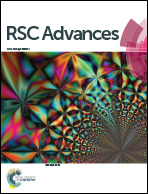Intermolecular interactions in dictating the self-assembly of halogen derivatives of bis-(N-substituted oxamato)palladate(ii) complexes†‡
Abstract
Three palladium(II) complexes of formula (n-Bu4N)2[Pd(4-Fpma)2] (1), (n-Bu4N)2[Pd(4-Clpma)2]·4H2O (2) and (n-Bu4N)2[Pd(4-Brpma)2]·4H2O (3) [n-Bu4N+ = tetra-n-butylammonium cation, 4-Fpma = N-4-fluorophenyloxamate, 4-Clpma = N-4-chlorophenyloxamate and 4-Brpma = N-4-bromophenyloxamate] have been prepared and their structures determined by single crystal X-ray diffraction. Each palladium(II) ion in 1–3 is four-coordinate with two oxygen and two nitrogen atoms from two fully deprotonated oxamate ligands building PdO2N2 square planar surroundings, the oxamate ligands exhibiting trans (1 and 2) and cis (3) dispositions. The fluoro substituent and the organic counterion in 1 are involved in C–H⋯F type interactions whereas the anionic complex assembly is driven by C–H⋯Ooxamate interactions. The structures of 2 and 3 shed light on the effects of the different chemical nature of chloro and bromo substituents on the C–H⋯X interactions joined to hydrogen bonds involving oxamate oxygen atoms and crystallization water molecules. The complex anions in 2 are interlinked by water chains to afford a supramolecular two-dimensional network where Ow⋯Ow, Ow⋯Ooxamate and Ow⋯Cl hydrogen bonds are involved. The reduction of the polarity of C–Br bonds with respect to C–X (X = F, Cl) is very likely to be one of the key reasons allowing for the cis-arrangement of the two 4-Brpma ligands around each palladium(II) ion of the anionic complex in 3 in water. These units are interconnected by hydrogen bonds between the peripheral oxamato-oxygens and a four-membered ring of water molecules leading to supramolecular cationic chains extending along the crystallographic a axis.


 Please wait while we load your content...
Please wait while we load your content...